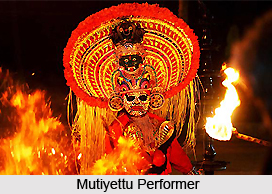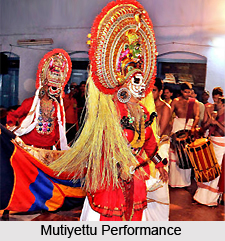 Mutiyettu is a ritualistic prototype of theatre, one of the earliest known representing the fertility cult in Kerala. Kali or the goddess of Shakti is the protagonist and Darika the demon antagonist.
Mutiyettu is a ritualistic prototype of theatre, one of the earliest known representing the fertility cult in Kerala. Kali or the goddess of Shakti is the protagonist and Darika the demon antagonist.
Subjects of Mutiyettu
The slaying of evil forces, represented by Darika and his elder brother Danava, by Kali and her retinue, the Kulis and Koimpidar forms the storyline. Koimpidar also calls the Koimpida Nayar i.e. a warrior who interjects with comical comments and dance. The leading twentieth-century exponent was Pazhoor Kunjan Marar. The musical prelude, called kalampattu or kalamezhutupattn, sometimes takes place by itself, not followed by the play.
Venue of Mutiyettu
It occurs within the building in front of a temple sanctum. When organized at people`s residences, a special pandal or thatched shed is erected in an open space in front of the house. Usually, this is decorated with fresh coconut leaves, flower garlands, and so on. The figure of Kali is drawn on the floor with five colours. This is known as kalam. The five colours are white i.e. rice powder, black i.e. charred rice husk, yellow i.e. turmeric, green i.e. leaves, and red i.e. lime and turmeric combined. This is drawn by two or three members of the community of temple artists known as Kurup. The consecrated floor has a central point from which Kali`s figure assumes shape slowly, through the spreading colours representing the energized cosmic presence. Her size varies according to the number of her hands, normally four to eight. On special occasions they may increase to sixty-four, in which the kalam occupies the large temple courtyard covered by a special pandal. Kali holds different weapons. Her breasts are represented by heaps of paddy and rice dotted with coloured powder.
Performance of Mutiyettu
Kalampattu i.e. pattu means ballad or poem, commences by dusk with rituals at the kalam. Drummers` sit on the side of the kalam and sing the tottam, the musical benediction narrate Kali`s story. This is also called nirampadal or `singing of colours`. This is because of the fact that it poetically describes the goddess from head to toe. It concludes with the ritualistic erasure of the kalam, using a bunch of tender coconut leaves. The figure becomes a muddle of colours with only the breasts intact, presumably symbolizing continuing fertility. The coloured powder is distributed to devotees as asprasadam or holy gift.
 The play begins in the open courtyard around the temple in the localized light of oil torches. The acting area changing from place to place as Kali and Darika shift their area of interaction. The audience also moves along with them, as active participants in the event. The atmosphere gets charged with the combatants` battle cries and the crowd`s enthusiasm. The story has it that Darika, by undergoing strict penance, managed to get a boon from Brahma that he would never be killed by anyone other than a woman. Another part of it was that if a drop of his blood fell, a thousand Darikas would emerge from it. Thus protected, he set out with his brother and the demons to oppress virtuous humans. The drama starts with the sage Narada reporting their misdeeds to Siva, lord of destruction. Kali, born from Siva`s third eye, is deputed to save the world from the evil. Darika makes his entrance behind a hand-held curtain and enacts his indomitable prowess. Likewise, the conventional curtain-look by Kali follows. Then the other characters enter.
The play begins in the open courtyard around the temple in the localized light of oil torches. The acting area changing from place to place as Kali and Darika shift their area of interaction. The audience also moves along with them, as active participants in the event. The atmosphere gets charged with the combatants` battle cries and the crowd`s enthusiasm. The story has it that Darika, by undergoing strict penance, managed to get a boon from Brahma that he would never be killed by anyone other than a woman. Another part of it was that if a drop of his blood fell, a thousand Darikas would emerge from it. Thus protected, he set out with his brother and the demons to oppress virtuous humans. The drama starts with the sage Narada reporting their misdeeds to Siva, lord of destruction. Kali, born from Siva`s third eye, is deputed to save the world from the evil. Darika makes his entrance behind a hand-held curtain and enacts his indomitable prowess. Likewise, the conventional curtain-look by Kali follows. Then the other characters enter.
Since the theme is conflict, the fight between Kali and Darika assumes prime importance, happening at different places. Each time, Kali grows furious and chases with Darika, who flees. Stagehands tightly hold Kali so that she cannot wriggle out. Every battle is fought with renewed vigour, creating a crescendo of frenzied drumming and dancing; the performance goes on till midnight or later. There are also verbal duels. The opposing forces create a hue and cry and come to loggerheads, at the end of which Darika disappears from the arena and Kali`s headgear. At the height of her fury, is snatched away by the stagehands. In the middle of battle sequences, Koimpidar`s entry provides comic relief. The last fight culminates in the possessed Kali slicing a bunch of plantain fruit, ritualistically representing the slaying of Darika. She makes her final appearance dancing with Darika`s headgear, followed by guruti. This is the concluding ceremony of offering blood i.e. a mixture of turmeric paste and lime at the goddess`s altar.
In southern Kerala, the ritual connected with Kali worship is called Parnettu or Kaliyuttu i.e. `feeding of Kali`. This one is usually done enacting the same theme with certain striking differences from Mutiyettu in execution and other details. The playing area is much bigger, accommodating 10,000 or even more, on the side of the temple, not around as in the case of Mutiyettu. At the two ends of the rectangular field, high platforms are built with stairs to climb onto them. One of them i.e. Kali`s seat is made of trunks of coconut trees. But Darika`s seat is usually higher than the other. This is made of areca trunks. These platforms are known as parna, hence the name Parnettu or `climbing on the parna`. The battles take place in the arena, around which huge crowds congregate. The performance begins at around four in the evening. The descending sun providing spectacular scenic brilliance goes on through the night. Darika runs out of the temple precincts pursued by Kali. They shout war cries from their respective platforms. At regular intervals they descend and taunt and chase each other, sometimes fighting pitched battles. The double-reed nagaswaram and tavil or double-faced drums are the accompanying instruments. The ritual ends with a sacrifice at the sanctum in the small hours of the morning.




















